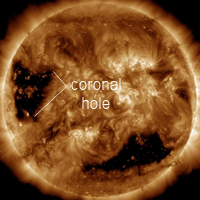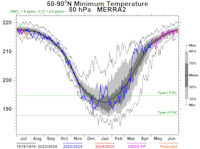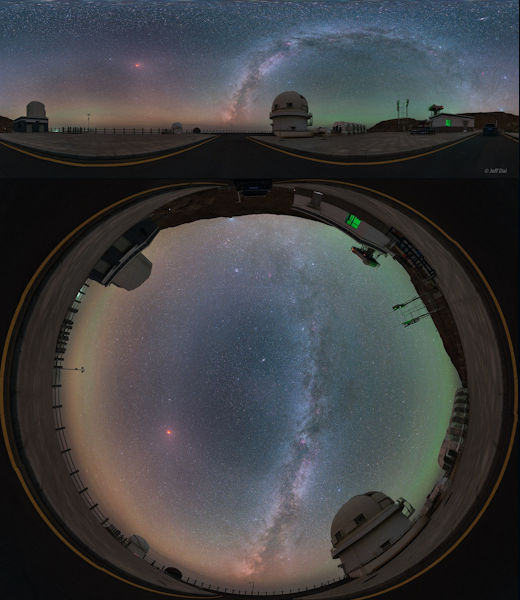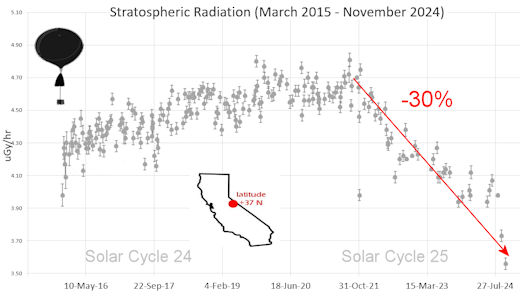 | | | Switch to: Europe, USA, New Zealand, Antarctica Credit: NOAA/Ovation  Planetary K-index Planetary K-index
Now: Kp= 2.67 quiet
24-hr max: Kp= 3.67 quiet
explanation | more data
Interplanetary Mag. Field
Btotal: 5.51 nT
Bz: 1.09 nT north
more data: ACE, DSCOVR
Updated: Today at 1000 UT  Coronal Holes: 08 Sep 25 Coronal Holes: 08 Sep 25 
Solar wind flowing from this emerging coronal hole could reach Earth on Sept. 13-14. Credit: NASA/SDO | more data  Polar Stratospheric Clouds
Colorful Type II polar stratospheric clouds (PSC) form when the temperature in the stratosphere drops to a staggeringly low -85C. NASA's MERRA-2 climate model predicts when the air up there is cold enough: 
On Sep 07, 2025, the Arctic stratosphere is much too hot for polar stratospheric clouds. | more data. Noctilucent Clouds
The northern season for noctilucent clouds is underway. First reports of the electric-blue clouds came from Russia on May 28, 2025. Since then, the clouds have spread to lower latitudes, reaching Paris, France, during a major outbreak on June 23, 2025. The seson is ending in an interesting way. Usually the clouds vanish in August, but they have persisted and sometimes been quite storng as August comes to an end.

Above: Aug. 21, 2025, Björköby, Finland
"These late season noctilucent clouds drifted in front of the crescent moon. It was quite beautiful," says photographer Sebastian Sainio.
See the complete NLC Photo Gallery
 SPACE WEATHER
NOAA Forecasts | | Updated at: 2025 Sep 08 2200 UTC FLARE | 0-24 hr | 24-48 hr | CLASS M | 25 % | 25 % | CLASS X | 01 % | 01 % |  Geomagnetic Storms: Geomagnetic Storms:
Probabilities for significant disturbances in Earth's magnetic field are given for three activity levels: active, minor storm, severe storm Updated at: 2025 Sep 08 2200 UTC Mid-latitudes | 0-24 hr | 24-48 hr | ACTIVE | 20 % | 20 % | MINOR | 05 % | 05 % | SEVERE | 01 % | 01 % | High latitudes | 0-24 hr | 24-48 hr | ACTIVE | 15 % | 15 % | MINOR | 30 % | 30 % | SEVERE | 25 % | 25 % | | | |  | | | | | | | | | | | This is an AI Free Zone: Text created by Large Language Models is spreading across the Internet. It's well-written, but frequently inaccurate. If you find a mistake on Spaceweather.com, rest assured it was made by a real human being. | | | WAITING FOR THE CME: A faint CME expected to strike Earth on Sept. 7th either missed or its impact was too weak to register in solar wind data. An overdue arrival on Sept. 8th could spark a minor G1-class geomagnetic storm. The CME was hurled into space by a sigmoid eruption on Sept. 4th. CME impact alerts: SMS Text LUNAR ECLIPSE REVEALS THE UNSEEN: Last night, the full Moon vanished into Earth’s shadow--and the stars came out. Across Asia, Africa, Europe, and Australia, millions witnessed a sudden transformation. "When the lunar eclipse entered the total phase, I was stunned by the sight before me," reports Jeff Dai of Qinghai, China. "The Milky Way became extremely bright during totality." 
"In this panoramic image stitched together from multiple photos, the zodiacal light and gegenschein are surprisingly visible," says Dai. "Near the horizon, airglow can also be seen--it was truly unparalleled." These are things normally visible only on the darkest nights. With the full Moon dimmed to a red ember, Sept. 7-8 became such a night, revealing the seldom seen. Our photo gallery is filling fast with images from around the world (except the Americas, which missed out). Browse the realtime submissions here: Realtime Space Weather Photo Gallery
Free: Spaceweather.com Newsletter SOLAR SYSTEM EARRINGS FROM SPACE: These earrings have flown to the edge of space--and all eight planets are included! On May 21, 2025, the students of Earth to Sky Calculus launched the Solar System Stud Earrings to the stratosphere onboard a cosmic ray research balloon. At the apex of the flight, they floated 104,655 feet high: 
You can have the complete set for $99.95. Only Pluto is omitted from the collection; the dwarf planet was too small for human earlobes. The earrings come with a greeting card showing the studs in flight and telling the story of their journey to the stratosphere and back again. Far Out Gifts: Earth to Sky Store
All sales support hands-on STEM education
Realtime Aurora Photo Gallery
Free: Spaceweather.com Newsletter
Realtime Space Weather Photo Gallery
Free: Spaceweather.com Newsletter Every night, a network of NASA all-sky cameras scans the skies above the United States for meteoritic fireballs. Automated software maintained by NASA's Meteoroid Environment Office calculates their orbits, velocity, penetration depth in Earth's atmosphere and many other characteristics. Daily results are presented here on Spaceweather.com. On Sep 08, 2025, the network reported 11 fireballs.
(9 sporadics, 2 September epsilon Perseids)  In this diagram of the inner solar system, all of the fireball orbits intersect at a single point--Earth. The orbits are color-coded by velocity, from slow (red) to fast (blue). [Larger image] [movies] Potentially Hazardous Asteroids ( PHAs) are space rocks larger than approximately 100m that can come closer to Earth than 0.05 AU. None of the known PHAs is on a collision course with our planet, although astronomers are finding new ones all the time. On September 8, 2025 there were 2349 potentially hazardous asteroids.
 | Recent & Upcoming Earth-asteroid encounters: | Asteroid | Date(UT) | Miss Distance | Velocity (km/s) | Diameter (m) | | 2025 QG16 | 2025-Sep-03 | 6.5 LD | 11.9 | 19 | | 2025 QV5 | 2025-Sep-03 | 2.1 LD | 6.2 | 12 | | 2025 QD8 | 2025-Sep-03 | 0.6 LD | 12.8 | 21 | | 2025 RA | 2025-Sep-03 | 18.7 LD | 5.9 | 29 | | 2025 QM6 | 2025-Sep-03 | 10.9 LD | 10 | 56 | | 2025 PF3 | 2025-Sep-03 | 16.3 LD | 6.9 | 22 | | 2025 RM1 | 2025-Sep-03 | 0.3 LD | 12.5 | 41 | | 2025 RE | 2025-Sep-04 | 6.2 LD | 10.2 | 14 | | 2025 QV11 | 2025-Sep-04 | 16.2 LD | 11.4 | 29 | | 2025 RA1 | 2025-Sep-04 | 8.8 LD | 12.3 | 25 | | 2025 RR1 | 2025-Sep-05 | 6.6 LD | 15.4 | 73 | | 2025 OG1 | 2025-Sep-05 | 14.5 LD | 4.2 | 35 | | 2025 QB21 | 2025-Sep-06 | 1.6 LD | 5.8 | 18 | | 2019 JG1 | 2025-Sep-09 | 18.8 LD | 7.9 | 17 | | 2025 QV9 | 2025-Sep-10 | 5.2 LD | 4.6 | 33 | | 2025 QL7 | 2025-Sep-11 | 15.2 LD | 10.3 | 52 | | 2025 QJ17 | 2025-Sep-11 | 17 LD | 5.8 | 27 | | 2025 RR | 2025-Sep-11 | 11.3 LD | 22.4 | 47 | | 2009 FF | 2025-Sep-11 | 6.8 LD | 12.9 | 155 | | 2025 RU | 2025-Sep-11 | 8.4 LD | 18.7 | 28 | | 2025 QO1 | 2025-Sep-11 | 8.7 LD | 13.6 | 81 | | 2025 QL11 | 2025-Sep-12 | 6.1 LD | 5.4 | 15 | | 2025 QX9 | 2025-Sep-12 | 17.7 LD | 3 | 16 | | 2015 SA | 2025-Sep-13 | 10.3 LD | 9.1 | 31 | | 2022 SS2 | 2025-Sep-13 | 2.4 LD | 7.2 | 13 | | 2025 QV6 | 2025-Sep-14 | 18.1 LD | 6.9 | 40 | | 2025 QR1 | 2025-Sep-14 | 19.7 LD | 8.7 | 155 | | 2025 QK9 | 2025-Sep-16 | 4.2 LD | 8.4 | 51 | | 2025 FA22 | 2025-Sep-18 | 2.2 LD | 10.8 | 166 | | 2025 PJ1 | 2025-Sep-21 | 11.6 LD | 11.8 | 127 | | 2022 SW12 | 2025-Sep-23 | 15 LD | 17.6 | 210 | | 2018 QT1 | 2025-Sep-23 | 13.1 LD | 12.7 | 138 | | 2021 RN16 | 2025-Sep-23 | 10.1 LD | 8.8 | 7 | | 2019 SF6 | 2025-Sep-28 | 20 LD | 8.4 | 20 | | 152664 | 2025-Sep-29 | 10.1 LD | 18.6 | 412 | | 2025 QL23 | 2025-Oct-01 | 7.1 LD | 10 | 77 | | 2020 GE1 | 2025-Oct-02 | 13.7 LD | 4.7 | 14 | | 2022 TU1 | 2025-Oct-08 | 16.9 LD | 12.9 | 10 | | 2020 QU5 | 2025-Oct-09 | 7.1 LD | 13.6 | 26 | | 2022 AY5 | 2025-Oct-14 | 7.4 LD | 8.4 | 5 | | 2022 UY3 | 2025-Oct-15 | 10.2 LD | 7.4 | 15 | | 2022 UU15 | 2025-Oct-19 | 14.8 LD | 16.1 | 34 | | 2023 UK3 | 2025-Oct-21 | 6.7 LD | 9 | 5 | | 2024 GD2 | 2025-Oct-22 | 17.8 LD | 4.2 | 28 | | 2022 HM1 | 2025-Oct-23 | 15.1 LD | 13.3 | 27 | | 2012 TP231 | 2025-Oct-25 | 15.2 LD | 6.7 | 37 | | 2020 FA5 | 2025-Oct-26 | 15.7 LD | 26.5 | 210 | | 2009 HC | 2025-Oct-26 | 8.6 LD | 4.2 | 41 | | 434196 | 2025-Oct-27 | 17.4 LD | 10.9 | 171 | | 2023 VK6 | 2025-Nov-03 | 7.6 LD | 9.6 | 15 | Notes: LD means "Lunar Distance." 1 LD = 384,401 km, the distance between Earth and the Moon. 1 LD also equals 0.00256 AU. | | Cosmic Rays in the Atmosphere | SPACE WEATHER BALLOON DATA: Almost once a week, Spaceweather.com and the students of Earth to Sky Calculus fly space weather balloons to the stratosphere over California. These balloons are equipped with sensors that detect secondary cosmic rays, a form of radiation from space that can penetrate all the way down to Earth's surface. Our monitoring program has been underway without interruption for 10 years, resulting in a unique dataset of in situ atmospheric measurements. Latest results (Nov. 2024): Atmospheric radiation is sharply decreasing in 2024. Our latest measurements in November registered a 10-year low: 
What's going on? Ironically, the radiation drop is caused by increasing solar activity. Solar Cycle 25 has roared to life faster than forecasters expected. The sun's strengthening and increasingly tangled magnetic field repels cosmic rays from deep space. In addition, solar coronal mass ejections (CMEs) sweep aside cosmic rays, causing sharp reductions called "Forbush Decreases." The two effects blend together to bring daily radiation levels down. .Who cares? Cosmic rays are a surprisingly "down to Earth" form of space weather. They can alter the chemistry of the atmosphere, trigger lightning, and penetrate commercial airplanes. According to a study from the Harvard T.H. Chan school of public health, crews of aircraft have higher rates of cancer than the general population. The researchers listed cosmic rays, irregular sleep habits, and chemical contaminants as leading risk factors. A number of controversial studies (#1, #2, #3, #4) go even further, linking cosmic rays with cardiac arrhythmias and sudden cardiac death. Technical notes: The radiation sensors onboard our helium balloons detect X-rays and gamma-rays in the energy range 10 keV to 20 MeV. These energies span the range of medical X-ray machines and airport security scanners. Data points in the graph labeled "Stratospheric Radiation" correspond to the peak of the Regener-Pfotzer maximum, which lies about 67,000 feet above central California. When cosmic rays crash into Earth's atmosphere, they produce a spray of secondary particles that is most intense at the entrance to the stratosphere. Physicists Eric Regener and Georg Pfotzer discovered the maximum using balloons in the 1930s and it is what we are measuring today. | | The official U.S. government space weather bureau | | | The first place to look for information about sundogs, pillars, rainbows and related phenomena. | | | Researchers call it a "Hubble for the sun." SDO is the most advanced solar observatory ever. | | | 3D views of the sun from NASA's Solar and Terrestrial Relations Observatory | | | Realtime and archival images of the Sun from SOHO. | | | information about sunspots based on the latest NOAA/USAF Active Region Summary | | | current counts of failed and deployed Starlink satellites from Jonathan's Space Page. See also, all satellite statistics. | | | Authoritative predictions of space junk and satellite re-entries | | | from the NOAA Space Environment Center | | | fun to read, but should be taken with a grain of salt! Forecasts looking ahead more than a few days are often wrong. | | | from the NOAA Space Environment Center | | | the underlying science of space weather |  | Got a chipped or cracked windshield that prevents you from seeing space weather events while driving? Get windshield replacement from SR Windows & Glass with free mobile auto glass service anywhere in the Phoenix area. |  | BestCSGOGambling is the best site for everything related to CSGO gambling on the web | | | These links help Spaceweather.com stay online. Thank you to our supporters! | | | | | | | | |  | |  |   | ©2021 Spaceweather.com. All rights reserved. This site is penned daily by Dr. Tony Phillips. | |

